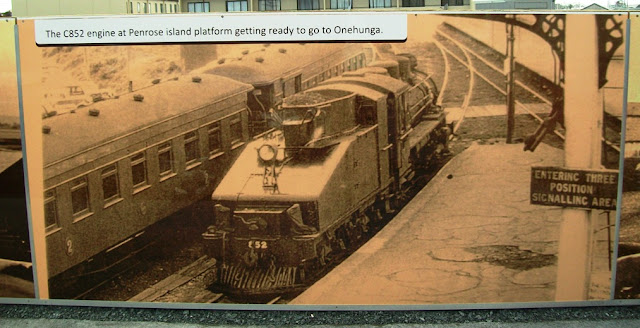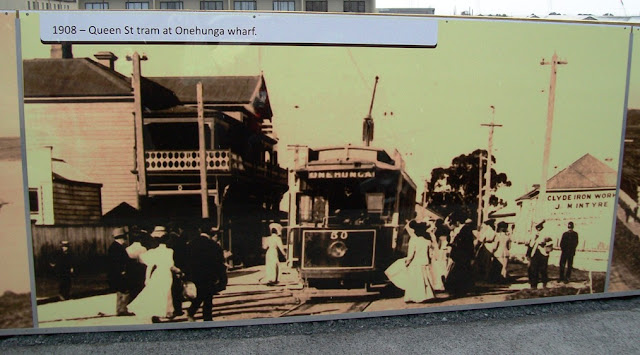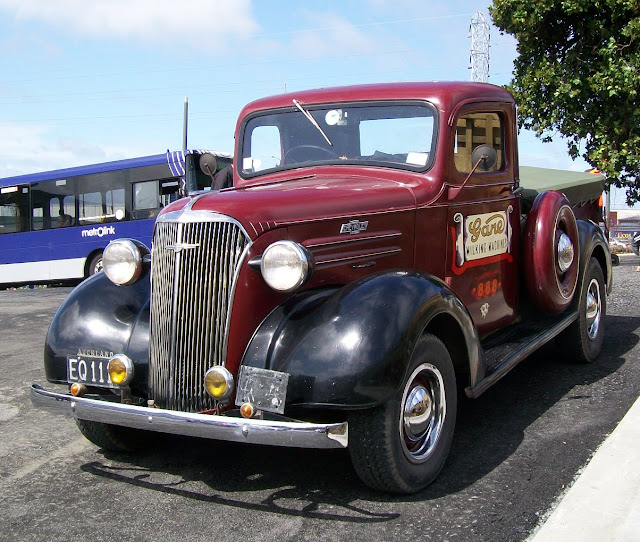Once upon a time, a part of Auckland called Onehunga had a railway station from 1873. From that point, the Auckland to Onehunga line was said to be the only railway line in New Zealand which spanned from coast to coast (due to central Auckland's geography, and that we're on an isthmus.) Passenger services lasted around 100 years, and then things were shut down during the 1970s.
Local campaigning this century, however, has led to a grand re-opening today of the branch line, slightly altered, but now leading passengers straight to the Onehunga Mall, heart of the local shopping centre. I could not miss the opportunity to see the action.
Or the very cool photo reproductions they've placed on the fenceline along Onehunga Mall and Princes Street. If things look a bit "rough and ready" with loose and bare soil, implements lying around, bits of wood -- that's because they still hadn't quite finished the landscaping today. The bitumen in the carpark was still spongy. The rollers, trucks etc. were still parked there this morning, an hour before ceremonies began.
"A Monday morning scene on Onehunga Wharf circa 1880."
"The first bank of Auckland in Onehunga."
"Shunting in Onehunga 1954."
"The Public Library and Post Office Hotel on Queen Street, Onehunga (now Onehunga Mall) circa 1879."
"The SS Wanaka and other sailing boats at Onehunga wharf. Mangere Mountain in the background."
"Sections of the original Onehunga station on the move to the Rail Enthusiasts Society site in Alfred Street, 1962."
"The first timetabled train to Onehunga, 24 December 1873."
"A painting, possibly by John Kinder, of Onehunga looking south west."
"L" class locomotive used on Onehunga line, circa 1906."
"Looking south down Queen Street, Onehunga, towards Mangere Mountain with a trolley bus travelling past the State theatre."
"Manukau to Onehunga Train route following the foreshore, 1954."
"The first 'South Auckland tour' rail fan special train arriving in Onehunga."
"The C852 engine at Penrose island platform getting ready to go to Onehunga."
"1908 - Queen St tram at Onehunga wharf."
"Onehunga station, looking back on to the Borough Council chambers building, 1954."
"An Epsom-Onehunga tram and a horse and cart travelling along Queen Street, Onehunga."
"A tram on Queen Street, Onehunga, 1908."
"The staff of Kauri Point Sawmill and their children gathered outside the premises on the corner of Beacroft and Princes Street, Onehunga, 1882."
I just love the horse in the photo. Lived a hard life, standing ever-so-patiently for the photo.
End of the line. Just beyond this point, according to a member of the Onehunga and Fencible Historical Society, the old station master's house used to be. The platform for the new station, by the way, is too short, according to news reports.
Taking photos of the trains on the platform proved difficult -- narrow platform, lots of people, wrong angle. I'm glad they sent an ordinary diesel along at first. It gave me the opportunity to scout out an alternative vantage point.
Board for those to inscribe their name for posterity, I suppose. No, I didn't sign ...
In case you come off the train and don't know where you are (despite all the blue and white signage) -- here's an extra clue.
There was a PC Plod on patrol, complete with truncheon.
The cutting for the old wharf connection still exists, along with the Neilson Street overbridge ...
... said bridge used for a local politics protest today, over the enforced acquistion of the Catholic school's land at Monte Cecelia by the present Auckland City Council.
More heritage stuff for folks to view.
At this point, I found my new observation site -- up on a bank, between a three-rail pipe fence and a hurricane wire fence. Despite the fact that I'm a 47-year-old overweight train-loving history buff, I made it over the pipe fence, and so was able to take the following shots.
Steam engine JA 1275 from Mainline Steam hauling two Tranz Scenic coaches, and backed by a diesel. Worth the two hour wait.
Looking at the shots here at home, I realised I had luckily caught these two characters as they disembarked from the train.
Also, another surprise -- a cool Chevrolet truck on the spongy bitumen.
And an older form of transport doing a circuit up and down Onehunga Mall.




































